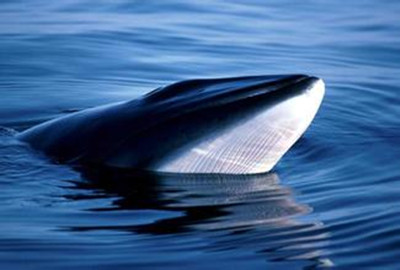In the 1960s submarine teams in the Southern Ocean first heard.
二十世纪六十年代在南大洋的潜艇队首次探测到这样的奇怪声音。
The sound reminded the submariners of a duck.
潜艇人员感觉这种声音像是鸭子叫。
So they dubbed the mysterious sound the bio-duck.
因此他们将这一奇怪的声音称作仿生鸭子。
Since then, scientists have frequently recorded the bio-duck sound in Antarctic waters.
从那时候开始,科学家们在南极地区水域常会探测并记录到这种仿生鸭子的叫声。
But its source remained unknown. Until now.
但是声音的来源一直还是个谜。直到最近谜底终于揭开。
In 2013 researchers attached sensors to two Antarctic minke whales.
2013年,科学家们在两头南极小须鲸身上安装了传感器。

The tags could track depth and location—and also record vocalizations.
这种标记可以追踪它们所处的位置和深度—当然也可以记录发出的声音。
Over a combined total of 26 hours, 32 calls were captured—including some low-pitched pulses.
总计超过26小时的记录时间内,一共收到32个声音文件—包括了一些低频声波脉冲信号。
Some of which matched recordings made nearby of the bio-duck sound.
其中有些与在附近水域内这种仿生鸭子的叫声音十分吻合。
The minke whale is thus revealed to be the source of the decades-old unidentified bio-duckitude.
因此近20多年来一直不确定来源的这些类似鸭叫的声音原来是小须鲸所发出。
The work is in the journal Biology Letters.
这一研究已在《生物学信函》杂志上发表。
Because minke whales swim in icy Antarctic waters, they're difficult to monitor, especially in winter.
因为小须鲸在冰冷的南极水域游泳,很难检测它们的行踪,特别是在冬季。
But by analyzing the collection of bio-duck sounds recorded over the decades, researchers may now be able to track their population size and migration patterns.
但通过分析近十几年来收集并记录到的类似鸭子的声音信息,研究人员们目前能够据此推测出它们的种群规模,数量以及迁徙活动模式。
But perhaps the bigger lesson: if it quacks like a duck...maybe it's a whale.
但或许更特别的信息是:如果有个动物的叫声像鸭子,也许有可能不是鸭子而是一头小须鲸呢。












